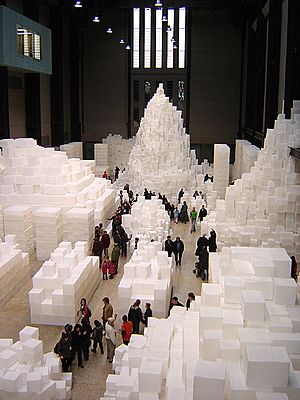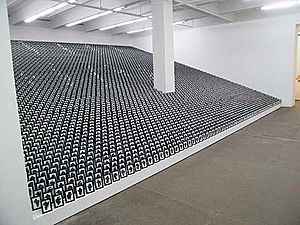Installation art facts for kids
Installation art is a cool type of visual art that uses three-dimensional objects. These artworks are often made to change how you see or feel about a space. Installation art can be set up for a short time or stay forever. You can find it in museums, galleries, or even in public places like parks. Usually, when we say "installation art," we mean art inside a building. Art outside might be called public art, land art, or intervention art, but these ideas can sometimes mix.
Contents
What is Installation Art?
Installation art is a unique way for artists to express themselves. It often uses many different materials, from everyday items to natural objects. Artists also use new media like video, sound, and even immersive virtual reality to create these pieces.
Many installations are site-specific. This means they are designed just for one particular place. They fit perfectly into that space and often use its features as part of the art. Some of the first ideas for installation art came from Marcel Duchamp in the early 1900s. But this art style really started to grow in the 1970s.
Today, with new technology, artists can make their installations even more exciting. They might use sensors to make the artwork react to people moving around it. This makes the art a fun experience for everyone!
How Installation Art Got Its Name
The word "Installation" for this type of art is quite new. It first appeared in dictionaries around 1969. People started using it to describe art that had been around for a long time but didn't have a special name until the mid-1900s.
Think of it this way: traditional art might be a painting on a wall or a sculpture on a stand. Installation art is different because it makes you experience the whole room or area. It's not just one thing to look at; it's an entire environment that surrounds you.
Interactive Art Experiences
Interactive installation is a special kind of installation art. In these artworks, the audience can actually do something to the art, or the art reacts to what people do. It's like the art talks back to you!
There are many types of interactive installations. Some use the internet, some are in galleries, and others use digital or electronic parts. Some artists even make installations you can control with your mobile phone! Interactive installations became popular in the late 1980s.
Virtual Reality in Art
As technology gets better, artists can try new and exciting things. They can go beyond what artists could do in the past. Today's art often mixes different media and might use sensors. These sensors can make the artwork respond to how people move when they look at it.
Immersive virtual reality art is one of the most interactive forms of art. It lets you "visit" the artwork as if you are inside it. Instead of just watching, you get to "live" the art experience. In recent years, many interactive installations use digital elements, video, film, sound, and sculpture to create these amazing worlds.
Images for kids
-
An artwork called "Mad crab" made from plastic waste at Fort Kochi.
-
Guardians of Time by Manfred Kielnhofer at the Festival of Lights (Berlin) in 2011.
See also
 In Spanish: Instalación (arte) para niños
In Spanish: Instalación (arte) para niños








